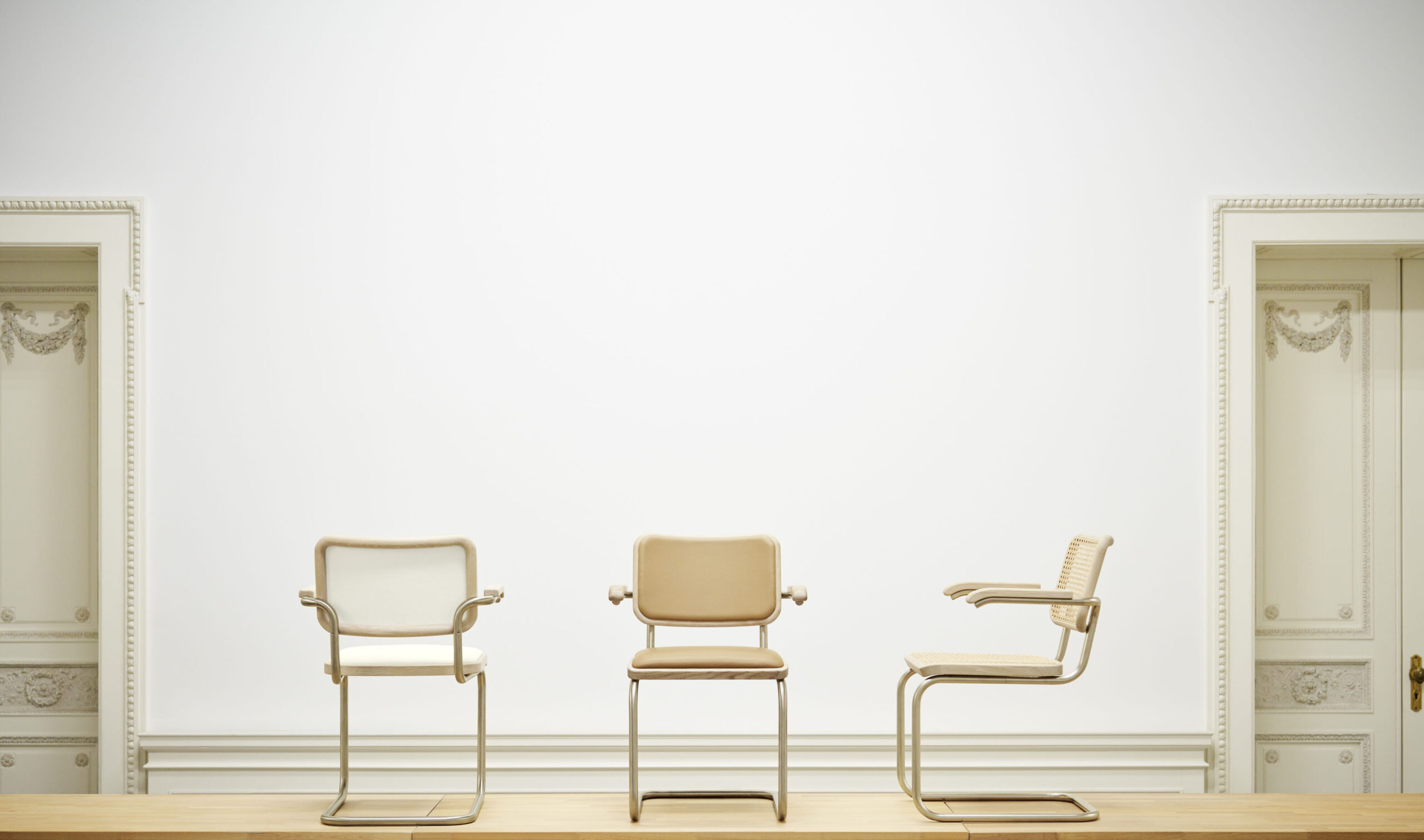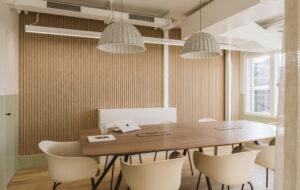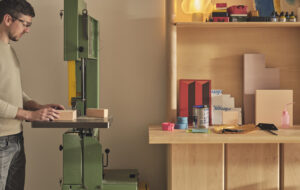 |||
|||
One word that probably sums up Spanish designer Jaime Hayon is “playful”. As the assembled design press and assorted industry types gather in BD Barcelona’s recently opened showroom in Clerkenwell during this year’s London Design Festival, it’s easy to be carried away with Hayon’s sense of fun as he veers from topic to topic – cheerfully giving us hints of his thought process: “A chair is like a bicycle”; “I’m not a designer like a designer – people take themselves too seriously”; “If there’s no theme, there’s no project”.
The reason Hayon was in the UK capital was a celebration of his work with the Spanish manufacturer over the past decade. To celebrate,BD Barcelona presented a retrospective of Hayon’s work – such as the punchy yellow Gardenias indoor armchair with pergola – with new variations on his Showtime collection on display, which were launched earlier this year.
The Showtime chairs, for example, are presented in new colours and lacquers and upholstery finishes, with more glossy lacquers and marble finishes for the Multileg cabinet and low tables. New versions of vases are finished with gold details and there are two new mirrors called King and Kong. Continuing the simian theme, Hayon’s seminal monkey table now comes in a solid piece with cement and a varnished mirror-effect polished brass tray. “I like to play around,” says Hayon. “Like, is the monkey really going to serve you?”
 Gardenias indoor armchair with pergola, 2014
Gardenias indoor armchair with pergola, 2014
 Showtime chair with sled base, 2007
Showtime chair with sled base, 2007
If a week is a long time in politics, then ten years is an awfully long time in design. What has changed in the way Hayon works, I ask? “I have changed a lot – a sense of planning,” he says. “I get a lot more done in a lot less time. I focus on things I like. When you’re younger, you have to prove yourself, you lose yourself. When you’re older you have less time for the bullshit.” Like any creative of his vintage, he slightly bemoans the internet age of incessant Instagramability, where before there was “more time to look at things”.
But while he claims that the bunny suit –once his go-to outfit – no longer fits, there is that same unpredictable excitement to Hayon now as then. Born in 1974, he studied industrial design in Madrid and Paris before joining Fabrica, the Benetton-funded design and communication academy in Italy – in 1997. At the start of this century, he set up his own design studio.
 Portraits by KlunderBie
Portraits by KlunderBie
Hayon’s official status according to his website is “artist-designer” and he doesn’t see a need to differentiate between the two disciplines: “There’s no such thing as a division at all. Ideas speak to each other.” One of his first major art shows was at London’s David Gill Gallery in 2003, with an exhibition entitled Mediterranean Digital Baroque.
You can see this blurring of the boundaries between art and design in projects such as the Palette desk for Danish firm &tradition, a series of desks which pair two different shapes together in a mix of materials – intended to be reminiscent of kinetic sculptures by American artist Alexander Calder. “It’s a homage to this supremely simple concept of poetry in motion,” he says. “A desk,” he muses, “is where we are supposed to sit still and make a decision. And yet it is also where we find distraction.” The shapes and materials are, he claims, intended to bring a bit of order to the chaos of the office. Tabletops are honed in marble or brass with the powder-coated steel tubes forming the base bringing a touch of modernity.
 Monkey side table for indoor or outdoor use, 2015
Monkey side table for indoor or outdoor use, 2015
For his Formakami lamps, also designed for &tradition, Hayon riffed on the idea of the paper lantern design which has been around for centuries. To give added illumination, he cut the bottom shape in half, leaving it open. The result is a clever reinvention of a classic design. He describes the result as very Asian and yet at the same time Scandinavian.
Speaking of which, Hayon is due to be the guest of honour at February’s Stockholm Furniture Fair and mentions the concept of “Scandavian tropical”, a hint perhaps to what he has in mind for the major installation at this particular trade show? “Put together two words that don’t match and you have something new,” he says.
 The Palette desk is a homage to Calder’s kinetic sculptures
The Palette desk is a homage to Calder’s kinetic sculptures
Ideas, like soundbites, are one thing Hayon is not short on. “Inspiration comes from conversations – it comes from being open to new things. It’s not hard for me to come up with new ideas.” He talks of an idyllic domestic set-up where he “looks for the shadow in the morning to sit out in my house in a village on the outskirts of Valencia where the people have no idea what I do.” He compares design to cooking, continuing the metaphor with the image of making a great curry and going to the supermarket and being inspired by different ingredients to make the perfect combination of flavours.
His work, he says, combines the craft and the industrial. For the Vico sofa for Cassina, named after his son and launched at the Salone del Mobile in 2014, he researched the Italian manufacturer’s archives, particularly from the 1950s and 60s to continue Cassina’s tradition of producing finely crafted objects and developing this sofa design in contemporary context.
 Formakami is Hayon’s reinvention of the paper lantern
Formakami is Hayon’s reinvention of the paper lantern
He says he remains a very Spanish designer – and, for that matter, very Spanish, referencing the fact his mother is concerned about how many tortillas he is eating. His Mila chair for Magis, for instance, has its design roots in the elastic and dynamic forms of Catalan modernism, while harnessing Magis’s expertise in gas injection mouldings. And Hayon’s tile collection for Bisazza is intended to be a design suffused with the Galician hills, the boulevards of Valencia and the twinkling stars of the Mediterranean.
Hayon collaborated with Spanish fashion brand Camper on a project entitled Together, to promote the brand in a more experiential way. Furniture such as wooden tables with multiple legs and terracotta lamps were handcrafted, with a glossy resin floor. The effect is somewhat Alice in Wonderland-like, with a dash of luxury and shades of Mediterranean red in abundance. And as for fellow Spaniard Patricia Urquiola, he says, “She’s a little bit of a fascination for me” – in a conversation where Ettore Sottsass and Philippe Starck are cited as key design references.
 Spicy colours for Fritz Hansen’s Sammen chair
Spicy colours for Fritz Hansen’s Sammen chair
 Room 506 at Copenhagen’s Radisson Blu Royal hotel
Room 506 at Copenhagen’s Radisson Blu Royal hotel
That said, Hayon is truly international presence, with offices in Italy, Spain and Japan. He has worked with manufacturers all over Europe and beyond – among them Sé London, Bernhardt Design and Moooi. His Sammen chair for Fritz Hansen is available in a range of hues – “Such spicy colours, I’m a spicy guy”. Originally for dining, its wooden legs and soft padded shell give it a life outside a residential environment. And as architects and specifiers consistently want that home-from-home feeling in the workplace, it has a certain flexibility. As he points out: “Around the dinner table is where we eat, meet, work and discuss life’s events.”
His life motto, he says, is “Have fun”. He elaborates: “You have to have fun in this line of work because we’re all going to die.” You can see this reflected in projects such as the Sparkle Shady chandelier for Swarovski, made up of series of lampshades, which Hayon describes as a “game of light”. This takes the form of several typologies in terms of size, with options in terms of the “skin” for each of the shades, which makes for further variations in colour of the chandelier. In this way the serious business of producing Swarovski crystals is still at the heart of the design, but is given a light-hearted Hayon twist. Similarly, for his Funghi Collection for Metalarte, the shape of the lights has been inspired by mushrooms, with the earthy colours of the ceramic intended to recreate the light and textures that are found in a forest.
 The Sparkle Shady chandelier for Swarovski
The Sparkle Shady chandelier for Swarovski
Beyond his products, Hayon has a number of interior projects of note to his name. Following in the not insubstantial footsteps of Arne Jacobsen, in 2014 he designed a room in the Radisson Blu Royal Copenhagen hotel (known in Jacobsen’s day as the SAS Royal Hotel). Together with Fritz Hansen, Hayon created bespoke furniture pieces, as well as some other bespoke designs and works of art.
And last year at the Groninger Museum in the Netherlands, Hayon’s studio created a new Discovery Space and Studio. Themed around a jungle, it features mask-like motifs and a large workbench that looks like a snake. Far from fusty, it is open to school groups during the week and creatives of all ages over the weekend, with space for presentations, performances and events. The space defies the “please don’t touch” ethos of museums of old and instead replaces it with cabinets and drawers to browse through, pieces that are intended to be touched, an interactive playground to create works of art or play “style stacking” to learn more about different painters’ techniques.
For all his bombast, even Hayon I don’t think would claim thus far to be Gaudí or Picasso, but nonetheless his fascination for channelling a certain childlike wonder into his designs means that perhaps given a few more decades he might be up there with the Spanish design greats.
 The Discovery Space and Studio at Groninger Museum
The Discovery Space and Studio at Groninger Museum
Why the designer doesn’t want to get serious
























